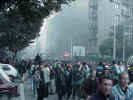Germany, Italy, and Canada Question NATO’s Targeting
Decisions since Civilians Die
German Foreign Minister Joschka Fischer said Friday that
"talks are urgently needed" among NATO members regarding the selection of
targets for the NATO air campaign. Clarifying Fischer’s remarks, German Foreign
Ministry spokesman Martin Erdmann said that NATO needed to
plan its bombing campaign to "more effectively avoid damaging civilian targets." The German statements follow similar appeals on Thursday
from Canada and Italy for NATO to reassess its target choices. They also echo concerns
expressed by German Chancellor Gerhard Schroeder on Wednesday, when he suggested that NATO
target selection was being monopolized by the U.S. and the UK.
Disaffection with both the strategic and tactical conduct of
NATO’s air campaign is spreading within the organization. Debate has deepened
from a general argument about whether the air war is proving effective at achieving
NATO’s goals, to a substantive issue of whether, by damaging an
increasing number of civilian and diplomatic facilities, the
campaign is doing more harm than good. An increasing
number of NATO members are expressing their unwillingness to take the fall for what they
consider U.S. errors and their irritation at being frozen out of the decision-making
process. As collateral damage mounts, and Washington must defend not
only the bombing campaign in general but its tactical execution, Washington will find it
increasingly hard to maintain support within NATO for the campaign. Having ruled
out escalation to a ground war, and with time running out on the air campaign, we wonder
how long U.S. intransigence at the Moscow and G-8 negotiations can last.
NATO has come under increasing public criticism, and has seen
dissent from within its own ranks, following a series of accidental strikes on civilian
and diplomatic targets. On Friday, NATO spokesman Jamie Shea told reporters that
NATO had no intention of changing its targeting policy as a result of the incidents. Shea
insisted that military commanders would continue to take every precaution to hit targets
accurately. U.S. State Department spokesman James Rubin replied to the criticism, saying,
"In our view, NATO's air campaign clearly represents the most accurate and
discriminating use of air power in history."
Thanks to PGM – precision guided munitions, not perfectly guided munitions –
it no longer takes 300 bombs to destroy a target. It takes two. Reducing weapons
systems’ CEP – circular error probable – to one square meter means that
half – not all – of the rounds used will likely land in that one meter box. The
others could hit nearby or go wildly astray, perhaps hitting another portion of the
target, or a cow pasture, or an embassy. Add to this the intentional or unintentional
jamming of weapons’ guidance systems – with smoke, flares, clouds, or electronic
signals – and intelligence failures in target selection, and it is only surprising
that so few embassies, refugee columns, apartment blocks and hospitals have been hit.
The problem is that so few in the media, the general public, and even in NATO member
regimes understand the basic capabilities and weaknesses of weapons systems. Because they see video footage of cruise missiles flying through windows
with pinpoint accuracy, they believe all cruise missiles, laser guided bombs, and air to
ground missiles have such unfailing accuracy. This lack of understanding is dangerous, as
it leads to a flawed doctrine for the use of military power in situations that do not
impact the fundamental national interests of the U.S. and other NATO powers –
situations in which allied casualties and collateral damage are deemed unacceptable. PGM
allows there to be far, far less of the latter.


